
[All photos by BUILD LLC]
BUILD just finished up a residential project in Seattle’s Queen Anne neighborhood and it includes a stair design that we think you’ll find interesting. In our book, stair design is one of the most challenging aspects of architecture because of the bandwidth it requires. The building code regulates strict provisions over stair design, stairs are typically located where several materials integrate together, stairs can be geometrically complex, and stairs are often the architectural highlight of a project. An innovative stair design requires an architect to put their structural engineer cap on to some degree and, during construction, a modern stair requires several trades (framers, finish carpenters, steel workers, cabinet makers, etc) to coordinate and communicate successfully together. So basically, stairs are unusually complicated for their relative amount of square footage.
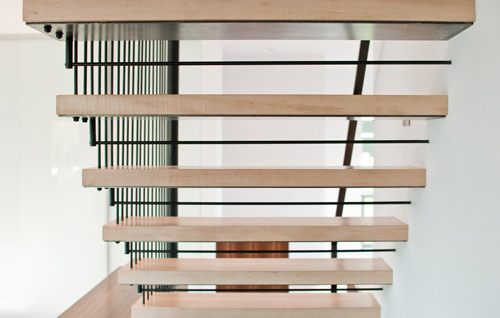
In addition to highlighting our latest stair, we’ve got 6 bullet points for successful stair design. These are some behind the scene tips that we’ve gathered over many years of designing, building, and pulling our hair out over stair design. Each point dives into the thinking and development of this particular stair. Enjoy.

Stair as focal point. The stair needs to be designed, constructed and paid for no matter what – so it might as well become a significant feature to the home. In this particular residence, the stair is located in the center of the house and can be seen from just about everywhere inside (and outside for that matter). In addition to this stair being perfectly functional, we designated it as a visual sculptural piece within the home. We decided to integrate the stair with the adjacent cabinets for a deliberate sense of harmony in the living spaces; the delicate vertical steel guardrails become a pleasing backdrop to the living room. Opening up the stairway also allows the adjacent rooms to feel a little more spacious.
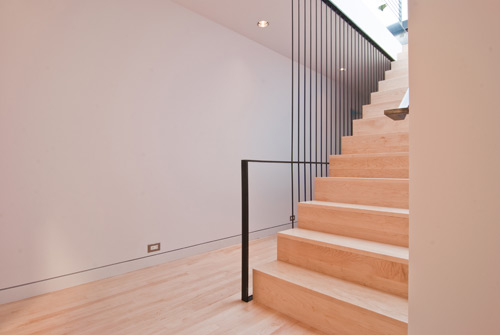
Beauty in translation. The building code has stringent parameters around stair design –right down to the very dimensions. While the governing codes could be viewed as limiting, they also offer design opportunities through their translation. We like to design with an “everything it needs to be and nothing more” attitude and the building code gives us a backbone to this philosophy. Every piece of steel, every dimension and every guard in this stair design is there for a reason; there’s nothing superfluous. A good example of this is the guardrail and handrail at the upper floor. Guardrails are not required when the difference between the treads and the floor is 30″ or less, so at the bottom/top of the stair run the guardrails terminate and allow the handrail (which is still required) to slide past. It’s a nice attenuated look; it’s also a diagram of the building code if you’ve got your x-ray vision on.
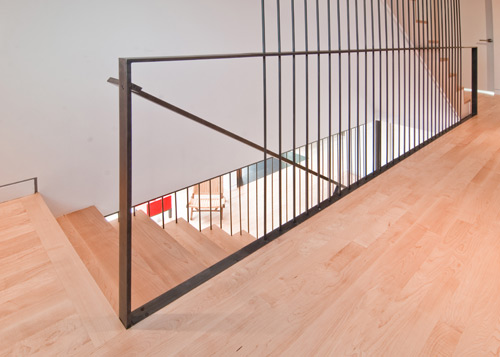

Double duty. When architecture is designed and constructed intelligently, it can perform a variety of functions at the same time. As the design of this stair developed it become clear that a bank of living room cabinets would provide practical storage and could also serve as a guardrail for the stair down to the basement.
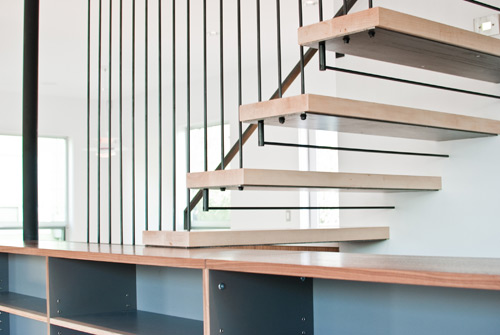

Intentional integration. Most stairs sit adjacent to other important functions; dovetailing those functions together is a great way to develop the craftsmanship and make everything count. Even the 4” diameter steel post at the bottom of the stairs (required to hold up the 2nd floor) is integrated into the composition here. The end of the kitchen counter aligns with the stair and the living room cabinets. In order for a composition like this (with steel, finish carpentry and cabinets) to come together nicely, everyone needs to be in synch. The cabinet maker has to ask the right questions of the steel worker and vice versa; the architect and builder have to be engaged in the conversation with their sleeves rolled up ready to problem solve.
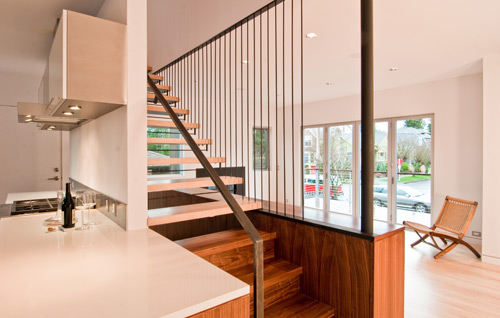
Develop a language. With most good design, there are rules at work behind the scenes. Elements meet where they do for specific reasons; material choices are made based on rationale. In other words there’s a language at play. In this stair, the language consists of three materials. Steel is used for its structural abilities where attenuation is needed most. The heavy walnut is used at the lower cabinets and the closed stair treads under 36” creating a dark band of wood at the base. The lighter maple hardwood treads are used above the level of the countertops to differentiate the break from closed risers and open risers; the maple also relates with the flooring at the level above. The horizontal steel guards between open risers (required by the building code) are extensions of the vertical steel guardrails.


[Click to Enlarge Image]

Dance with the variables. Construction is messy, there are a lot of moving parts, and the variables are in constant flux. When the site conditions change, exercise the flexibility to change with them -or dance with them, as we like to say. On this particular stair we were originally planning to align the 5th tread from the bottom with the top of the book cabinet and kitchen cabinet. The top of the book cabinet would have transitioned into one of the treads which would have been inset in the kitchen countertop as a cutting board. It would have been pretty slick. But the variables changed; we ended up raising the level of the main floor ceiling which, subsequently, changed the geometry of the stair. So we re-jiggered the design for the 5th tread to become a solid maple open tread that floats over the top of the adjacent cabinets. Maybe we’ll nail that flush tread on the next one…

There’s our five cents (or six cents) on stair design. We’d love to hear your ideas on stair design and see your favorite stairs out there. In case you missed it, we recently poked some fun at stairs that don’t meet the building code, check it out here.
Cheers from team BUILD.





